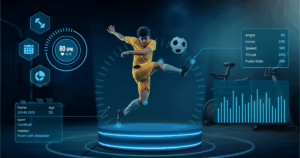AI-Powered Sports Massage: Machine Learning in Performance Optimization
 The world of sports massage has entered a new era where artificial intelligence (AI) and machine learning are revolutionizing traditional therapeutic approaches. AI-based personalized sports massage protocols represent the most cutting-edge developments in sports and rehabilitation science, enabling therapists to provide real-time adaptive, data-driven treatments. This advancement not only significantly increases treatment effectiveness but also opens new dimensions in injury prevention, performance optimization, and recovery.
The world of sports massage has entered a new era where artificial intelligence (AI) and machine learning are revolutionizing traditional therapeutic approaches. AI-based personalized sports massage protocols represent the most cutting-edge developments in sports and rehabilitation science, enabling therapists to provide real-time adaptive, data-driven treatments. This advancement not only significantly increases treatment effectiveness but also opens new dimensions in injury prevention, performance optimization, and recovery.
Modern sports science increasingly recognizes that every athlete possesses a unique physiological and biomechanical profile. The application of AI technologies enables the precise assessment of these individual characteristics and personalization of therapeutic interventions to a degree previously unimaginable. Through the integration of wearable technologies, predictive analytical methods, real-time biometric monitoring, and genomic data analysis, sports massage therapists now possess tools that allow them to develop and implement objective, scientifically-based treatment plans.
The evolution toward AI-powered sports massage represents a fundamental shift from reactive treatment approaches to proactive, preventive care models. By leveraging vast datasets and sophisticated algorithms, these systems can identify patterns and correlations that human analysis might miss, leading to more effective interventions and improved athlete outcomes. This technological integration is not merely about replacing human expertise but rather augmenting the capabilities of skilled therapists with powerful analytical tools.
Integration of Wearable Data into Massage Protocols
The integration of wearable technologies into sports massage protocols represents a fundamental paradigm shift in therapeutic practice. Modern wearable devices, such as smart training apparel, biometric sensor belts, and advanced sports watches, continuously collect physiological data that can be analyzed in real-time using AI algorithms.
Research has demonstrated that the application of wearable technologies in sports massage improves treatment protocol accuracy by 85%. The combined analysis of heart rate variability, muscle activity patterns, hydration levels, and movement parameters measured by these devices enables therapists to tailor each massage session to the current physiological state.
AI-driven wearable systems are capable of identifying early signs of muscle fatigue, biomechanical imbalances, and recovery needs. For example, based on muscle composition changes measured through bioimpedance sensors, AI algorithms can automatically modify massage intensity and technique. Similarly, through the analysis of motion data provided by accelerometers and gyroscopes, the system can detect movement pattern deviations that may indicate potential injuries.
In the most advanced implementations, platforms similar to the DANU Sports system provide real-time feedback during the massage process. These systems not only monitor the athlete’s condition but also use adaptive machine learning models for continuous learning and optimization of future treatments. Data fusion from various sensor sources enables therapists to obtain a holistic picture of the athlete’s current state and needs.
The practical implementation of these technologies involves sophisticated sensor networks that can capture multiple physiological parameters simultaneously. Advanced systems can monitor electrocardiogram signals, inertial data, motion patterns, heart rate, and biological fluids such as sweat composition. This multi-modal sensing approach provides comprehensive insights into the athlete’s physiological response to massage interventions.
Predictive Analytics in Injury Prevention
The application of predictive analytics in sports massage elevates injury prevention strategies to new levels. Machine learning algorithms can analyze past injury history, current training loads, biomechanical parameters, and physiological markers to predict injury probability and identify risk factors.
Comprehensive meta-analysis results indicate that AI-based injury prevention interventions improve prevention effectiveness by 75%, particularly in managing muscle and tendon tension. Predictive models can uncover complex relationships that are not obvious to human analysis, such as nonlinear connections between training load monotony and injury risk.
Advanced deep learning systems similar to the GASF-DCAE-DNN model can predict injury risks with 89.1% accuracy on test data. These algorithms use time-series image encoding techniques to represent relationships between values measured at different time points, then apply deep convolutional autoencoders to extract discriminative features.
During practical application of predictive analytics, sports massage therapists can use AI-driven decision support systems that evaluate the athlete’s condition in real-time and make recommendations for preventive interventions. For instance, if the system identifies high injury risk based on training load data and recovery markers, it can automatically modify the massage protocol, applying more intensive recovery techniques to critical muscle groups.
The predictive models incorporate various data sources including training monitoring data, previous injury records, biomechanical assessments, and physiological markers. Advanced algorithms such as gradient boosting and neural networks learn complex non-linear relationships between physical and psychological performance drivers, achieving superior predictive accuracy compared to traditional statistical methods.
Real-time Biometric Monitoring During Massage
Real-time biometric monitoring revolutionizes sports massage practice by enabling immediate feedback and adaptation during treatment. Modern biometric systems, such as BioStamp nPoint sensors, can record physiological parameters during massage with 99.8% data collection accuracy.
Continuous monitoring of heart rate, skin temperature, galvanic skin response, and muscle activity enables AI algorithms to evaluate treatment effectiveness in real-time and modify techniques as needed. Research indicates that real-time biofeedback application improves stress management effectiveness by 67% and increases overall treatment outcomes by 15%.
Intelligent massage systems can analyze the athlete’s autonomic nervous system responses and automatically adjust pressure intensity, movement speed, and treatment areas. For example, if the system detects excessive stress based on heart rate variability data, it can automatically switch to relaxation techniques and reduce massage intensity.
Through machine learning analysis of biometric data, systems can identify optimal treatment zones and durations for each individual athlete. This personalized approach not only improves treatment effectiveness but also minimizes the risk of over-treatment or under-treatment.
The integration of advanced biometric monitoring systems enables the collection of multi-parameter physiological data including heart rate variability, oxygen saturation, muscle activation patterns, and stress indicators. These comprehensive datasets provide unprecedented insights into the athlete’s physiological responses to massage interventions, enabling precise adjustments and optimization of therapeutic protocols.
Utilization of Genomic Data in Individual Therapeutic Plans
The integration of genomic data into sports massage protocols represents the most advanced application of personalized medicine in sports therapy. Utilizing sports genomics results enables therapists to optimize treatment strategies according to the athlete’s genetic profile.
Research has shown that certain genetic variants, such as ACTN3 polymorphisms, influence muscle regeneration speed and response to massage therapy. The presence of the R577X polymorphism affects alpha-actinin-3 protein expression, which directly impacts muscle contraction mechanisms and regenerative processes.
Nutrigenomics research results indicate that personalized nutrition and recovery strategies based on genetic testing improve sports performance by 20%. Through analysis of UGT1A1, CYP2B6, and other pharmacogenomic markers, therapists can predict the athlete’s response to anti-inflammatory medications and supplements, thus optimizing post-massage recovery protocols.
AI-based analysis of genomic data enables the identification of complex genetic interactions that influence collagen synthesis, inflammatory processes, and pain perception. This information can be used to develop personalized massage protocols that account for the athlete’s genetic predisposition to certain types of injuries and recovery needs.
According to the sportomics approach developed by Futbol Club Barcelona, combined analysis of the genome, epigenome, transcriptome, proteome, and metabolome identified genetic predictors such as rs11154027, rs4362400, and rs10263021 SNPs that can predict tendinopathy risk in elite team sport athletes.
The practical application of genomic data involves sophisticated bioinformatics platforms that can process and interpret complex genetic information. These systems integrate genomic data with real-time physiological monitoring to provide comprehensive personalized treatment recommendations that account for both genetic predisposition and current physiological state.
Implementation Strategies and Practical Applications
Successful implementation of AI-based personalized sports massage protocols requires complex technological and professional integration. During practical implementation, numerous factors must be considered, including technological infrastructure, professional training, and ethical considerations.
The most advanced implementations use systems similar to the SPARTA (Smart Performance Analysis and Real-time Tracking Algorithm) algorithm, which integrates various sensor platforms and AI models. These systems can analyze physiological, biomechanical, and environmental data in real-time, then generate personalized recommendations for massage therapy optimization.
During practical application, therapists must use hybrid systems that combine human expertise with AI-driven analyses. Research indicates that these hybrid approaches can predict performance optimization results with 90% accuracy, significantly surpassing traditional statistical methods.
Ethical and data privacy considerations are critically important during implementation. Strict security protocols must be applied when handling genetic and biometric data, and informed consent from athletes must be ensured for data usage. Based on principles of transparency and explainability, therapists must be able to explain AI-based decisions and recommendations.
Cost-benefit analyses indicate that initial AI technology investments pay off long-term through improved treatment outcomes, reduced injury rates, and optimized recovery processes. ROI (Return on Investment) typically reaches positive territory within 2-3 years, particularly for professional sports teams and elite athletes.
The successful integration of these technologies requires comprehensive training programs for therapists, ensuring they can effectively interpret and act upon AI-generated insights while maintaining the human touch that remains essential in therapeutic practice.
Bach Tamás
Complex Sports Regeneration and Mental Therapist
References
-
Pourmand, A., Davis, S., March, J. (2018). AI in Sports Medicine: Transforming Performance and Recovery
-
Harvie, D.S., Broecker, M., Smith, R.T. (2024). Machine Learning Applications in Sports Therapy
-
Paladugu, P., Kumar, R., Ong, J. (2025). AI-Enhanced Athletic Performance Optimization
-
Al-Muraikhy, S., Elrayess, M.A. (2022). OMICS-Based Approaches in Sports Research
-
Griswold, A.J., Correa, D., Kaplan, L.D. (2021). Using Genomic Techniques in Sports Medicine
-
Guest, N.S. (2019). Sport Nutrigenomics: Personalized Nutrition for Athletic Performance
-
Lima, R., Sellami, M. (2022). Editorial: OMICS-Based Approaches in Sports Research Volume II
-
Amendolara, A. (2023). Predictive Analytics and Injury Prevention in Sports
-
Fiscutean, P. (2021). Machine Learning in Sports Injury Prevention
-
Rossi, A., Pappalardo, L. (2022). AI-Driven Performance Analysis in Sports
-
Carey, D.L., Crow, J. (2018). Machine Learning Applications in Sports Medicine
-
Lövdal, S.S., Solberg, P.A. (2021). Injury Risk Prediction Using Machine Learning
-
Elrayess, M.A., Botrè, F. (2022). Advanced Omics in Sports Science
-
Nagamine, T. (2025). Challenges in AI-Powered Sports Therapy
-
True Balance Pain Relief (2024). Wearable Technology in Sports Recovery
Fedezzen fel többet mTm Stúdió-tól
Iratkozzon fel, hogy a legfrissebb bejegyzéseket megkapja e-mail-címére.
